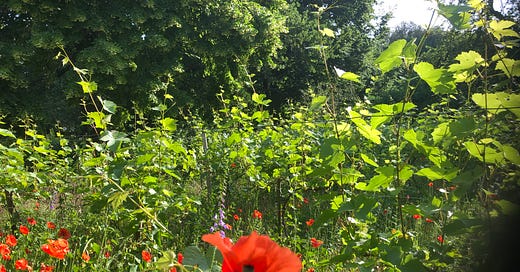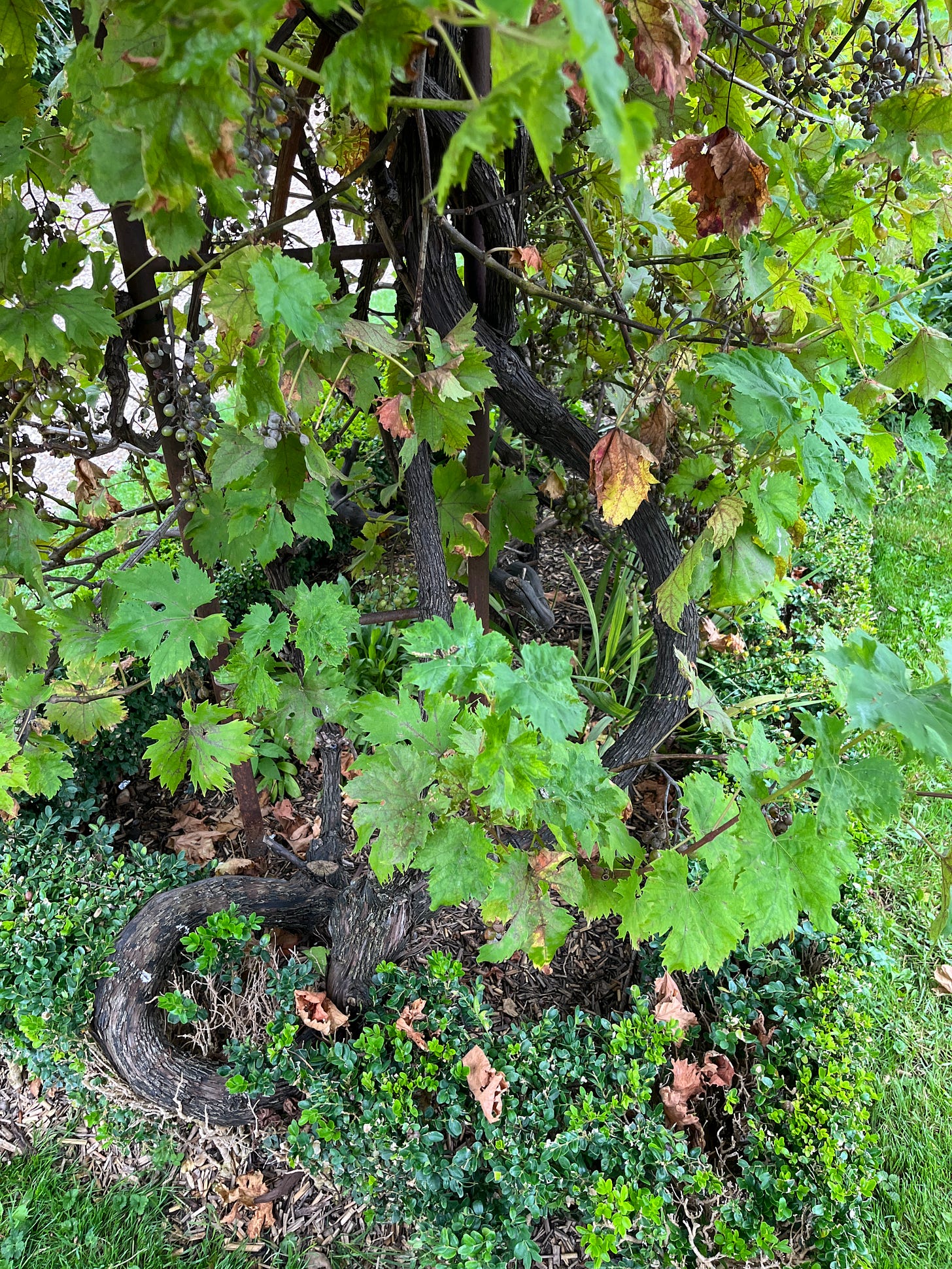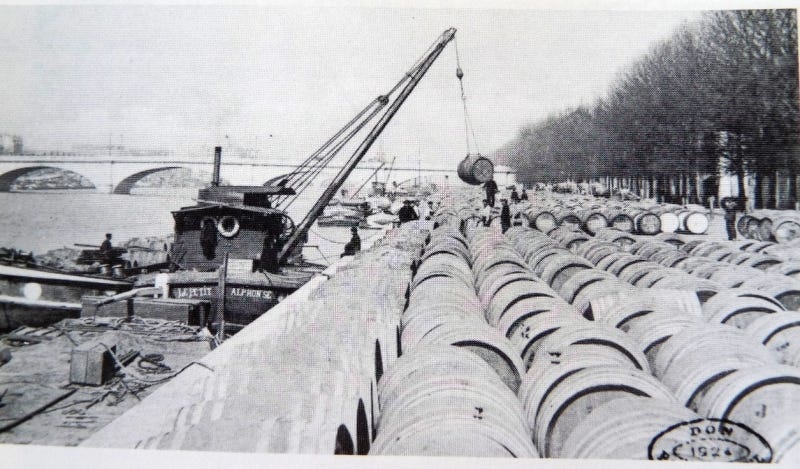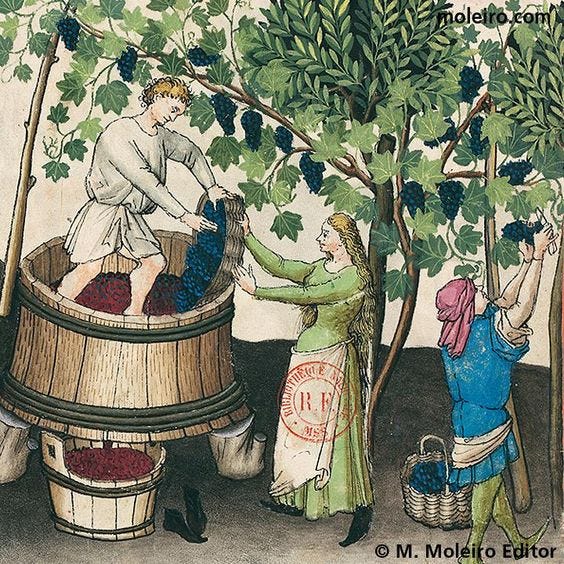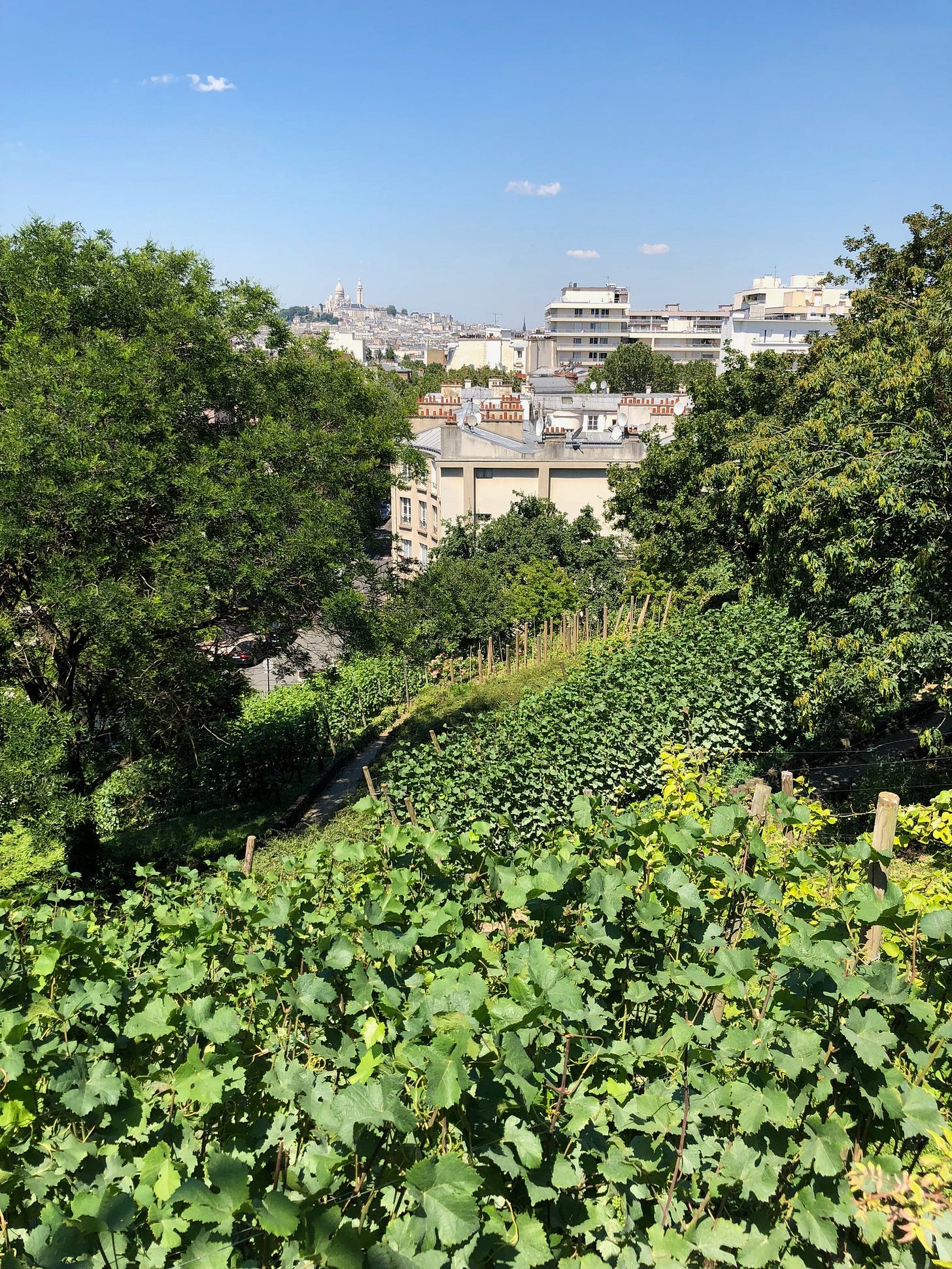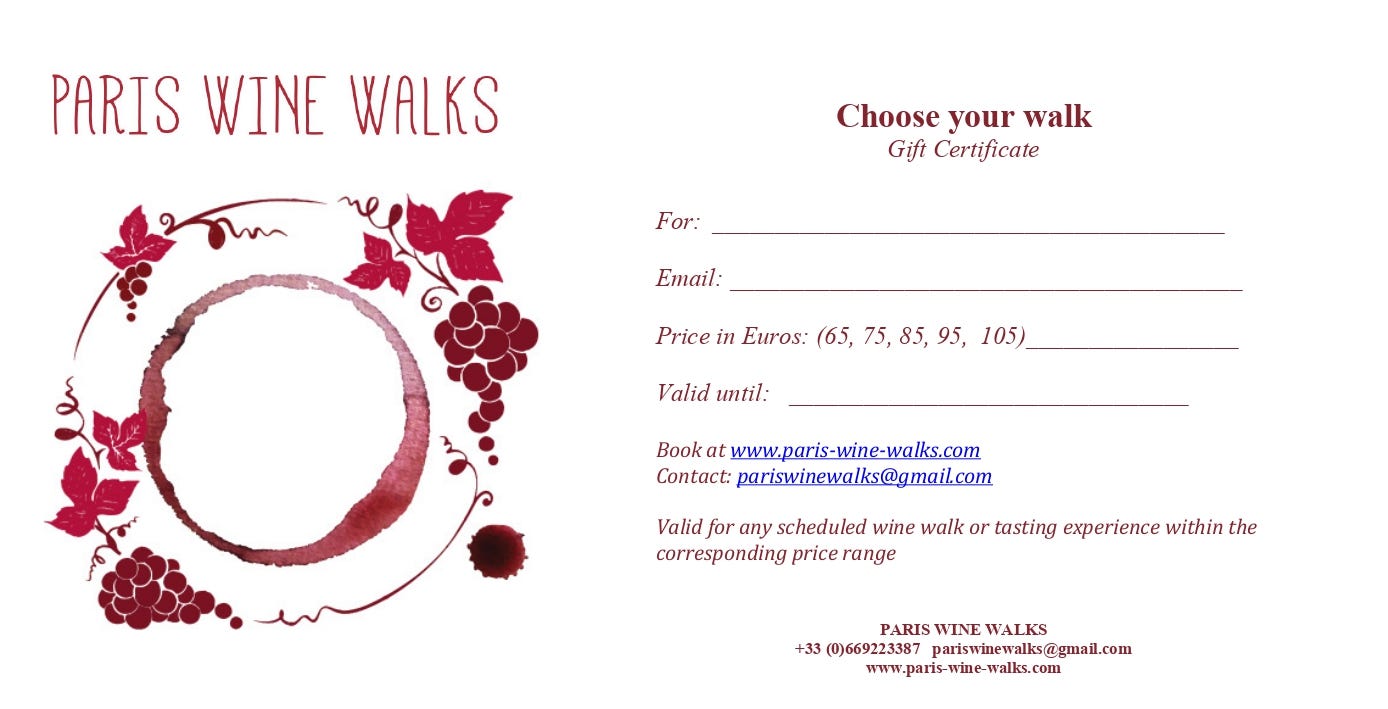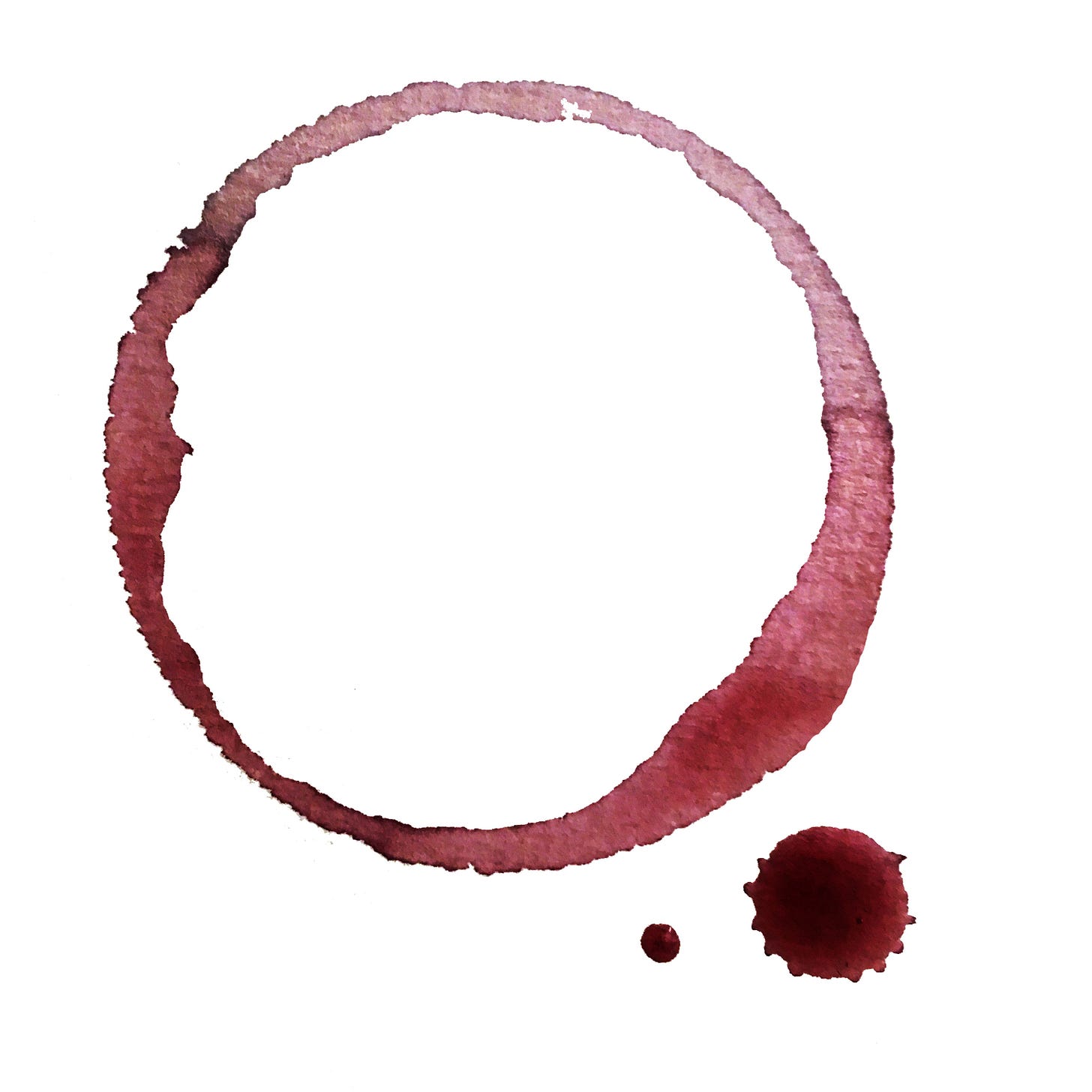The Urban Vine
“Wild grape-vines clamber to the tops of the highest trees, spreading umbrella-wise over the branches, and their festooned floating trailers wave as silken fringe in the play of the wind.”
(The above is an excerpt from ‘The Song of the Cardinal’ by Gene Stratton-Porter)
Urban viticulture is an anomaly. Urban agriculture is an anomaly. Why are there vineyards in Paris? How did this come about and more importantly, why are there new vines being planted practically every year?
Paris has a lot more vineyards than most people are aware (I count just under 30). It also has an extraordinary number of well-established individual vines growing in every quarter of the city, some nearly a hundred years old. The presence of the vine in the city goes unseen by most, even when there’s an entire vineyard staring them in the face. Yet for some, grapevines are a familiar presence, especially in the spring, summer and fall when they begin to bring forth fruit and their exuberant foliage reaches out in all directions to further extend their reach. They are hidden in the parks and the gardens of the city and in little squares where their presence is unobtrusive. They are in many ways anachronistic and somewhat out of place, planted in soils that have been planted to vines for more than 2000 years. They appear as if out of nowhere amidst the urban mosaic, persistent, wild, and vigorous, and yet discreet enough as to go unnoticed.
So what is a vine? What follows is adapted from various sources.
The grape vine, scientifically known as Vitis vinifera, is a woody perennial plant that belongs to the Vitaceae family. Vitis vinifera is characterized by its habit of climbing, with long, flexible stems that allow it to wrap around supporting structures. The leaves are palmately lobed, and the plant produces small, clustered flowers. The fruit of the grape vine, commonly known as grapes, varies in colour, taste, and size depending on the grape variety.
Vitis vinifera is a versatile plant that can adapt to a range of climates and soil types. Its ability to thrive in diverse environments has contributed to its widespread cultivation and endurance over the ages. The cultivation of grapes for winemaking is one of the oldest forms of agriculture. The fermentation of grapes into wine has been a cultural practice for millennia, contributing to the development of viticulture and the art of winemaking.
The grape vine has been a valuable commodity throughout history, contributing to trade and economic development. Regions with favourable climates for grape cultivation became known for their wine production, fostering trade networks and economic growth.
Beyond winemaking, grapes and grape products have been used in various culinary and medicinal applications. The consumption of fresh grapes, dried raisins, grape juice and wine has provided nutritional and health benefits, further solidifying the plant's importance.
The grape vine often holds cultural and religious symbolism. In various mythologies, it is associated with gods and goddesses, symbolising fertility, abundance, and divine blessings. In Christianity, the grapevine is emblematic of the Eucharist, representing the blood of Christ.
In many cultures, the grape vine is symbolic of prosperity, abundance, and fertility. Its lush foliage and bountiful fruit are often associated with a thriving and prosperous community.
There’s no question Paris is a thriving and prosperous community and though at first glance there’s no apparent connection between the vineyards of today and that prosperity, it is most definitely the vine that is at the heart of the city’s history.
Up until two centuries ago, the largest vineyard region in the entire world was the region around Paris. The legacy of that greatness has been reduced dramatically, but is nevertheless persistent, widespread and continuing to thrive.
The revegetation of cities has been aiding and abetting the return of the vine to Paris as vines are, like trees, long-lived (their lifespan is easily over 100 years), making them a solid ally for carbon sequestration. They are also very hardy and can put up with stressful and inhospitable environments without requiring a great deal of attention. If left alone, they’ll simply continue to grow, spreading their branches and leaves out in all directions, attaching themselves to whatever supports come within reach. When covering a wall, they can reduce the temperature on hot days by as much as ten degrees.
And in addition to all of that, they produce grapes, which can be eaten, pressed into juice, or fermented into wine. All in all, there are eleven vineyards in Paris producing wine, although the only one most people have ever heard of is the Clos Montmartre. Which is also the only one most people will ever be able to taste (join us on our Clos Montmartre wine walk to find out more).
Paris is not the only city with vineyards. Vienna is undoubtedly the largest with 1,700 acres of vines worked by over 600 different vintners, some large, some small. These are commercial vineyards, and the wines they produce preserve Vienna’s position as the last major European city with a thriving urban wine sector. The vineyards, a short metro ride from the city center, operate 'Heurigers' – a special type of wine tavern, permitted by law since 1784. In Heurigers, winemakers can sell their wines directly to customers, along with a limited selection of foods.
Enfield, London – Forty Hall Vineyard is a 10 acre community vineyard in Enfield, north London, the newest addition to Forty Hall Farm, a civic-minded project run by North Londoners to promote local, organic food. The vineyard’s first harvest was in 2013 and looked after primarily by local volunteers. The vineyard is the first commercial scale vineyard in London since the middle ages, producing English still and sparkling wines.
The Queens County Farm Museum’s Winery is part of New York City’s largest remaining tract of farmland (47 acres), a place where crops have been grown since 1697. The farm is in eastern Queens, just within New York City’s borders. The earliest vintage, a 2006 Cabernet Franc blend, has been followed up with Chardonnay, Cabernet Sauvignon and Merlot. While the Farm Museum is owned by the city government, the winegrowing operation is considered a true commercial vineyard, and is the only one in New York City.
Echo Park, Los Angeles – D’Augustine Vineyard. This self-described ‘tiny vineyard’ (strictly non-commercial) in the heart of Los Angeles is planted over entirely with Syrah, which produce 500 pounds of grapes in a good year. It’s really a labor of love for its owners, Heather and Joe D’Augustine. While the vineyard seems out of place in Los Angeles’ endless urban sprawl, the city was home to countless vineyards in bygone years, so you could say the D’Augustine’s are reviving a lost tradition.
In 2013, the city of Thessaloniki partnered with Domaine Gerovassiliou (a renowned winery outside the city) and a local university to plant Greece’s first urban vineyard. The initial plan called for 480 vines, all native Greek varieties: white Robola and Malagousia and red Agiorgitiko and Xinomavro. The project is meant to be educational, with the hope that the wines will be auctioned off in order to benefit the local community.
San Francisco, California – The Two Eighty Project. Winemakers Elly Hartshorn and Jenny Sargent planted 280 vines of Pinot Noir in their urban vineyard in 2013, releasing their first wine in 2016, the first to be grown in the city in over a century. Vineyards once ringed San Francisco, as in Los Angeles to the south. When the 1906 Earthquake torched the city, the vineyards were abandoned and many urban winemaking facilities were moved outside of the city. Their intention (according to their website) is to “revitalize the city as a diverse and equitable epicenter for locally-grown food, wine, and culture — and inviting everyone to contribute to lifting their community.”
What is truly fascinating about urban viticulture, is the connectivity. The connection to nature, the connection to the past, the connection with community and the connection with the spiritual. Vines tell stories as they live for many years and grow a little bit more from season to season. They are emblematic of a far greater story - one that unites people with the cycles of nature, the alchemy of fermentation, and the preservation of cultural practices that span millennia.
Visiting the vineyards of Paris is part of that connection.
“To take wine into our mouths is to savour a droplet of the river of human history” Clifton Fadiman
Give the gift of experience!
Paris Wine Walks Gift Certificates are available year round and make exceptional gifts
Sparkling Wine Splash
Immerse yourself in the effervescence of the season with our Sparkling Wine Splash experience. Whether you're celebrating a special occasion or just toasting to the joy of the holidays, our blind wine tasting of carefully selected sparkling wines invites friendly competition to see who can identify the Champagne among five fabulous sparkling wines. Book now!
Wine & Cheese Please
Indulge in classic and surprising pairings of wine and cheese with our in-depth Wine & Cheese Please tasting. Explore the nuances of flavour as our knowledgeable guides lead you through a ‘cultural’ tour de France, revealing the secrets of perfectly paired combinations. It's an ideal way to savour the sophistication of Parisian life. Book now!
Wine Walks!
For more information, click on the underlined links:
Clos Montmartre - Paris in Your Glass
Paris' most famous wine producing vineyard
Latin Quarter Unbottled!
An insider's journey to the oldest wine neighbourhood in the city
Wine Your Way Through the Marais
The Marais seen through a wineglass
Saint-Germain-des-Prés
Discover the vinous spirit of medieval Paris
3-Vineyard Cycling Tour
A comprehensive overview of medieval Paris
Paris Bottled!
Short on time? This one’s for you.


